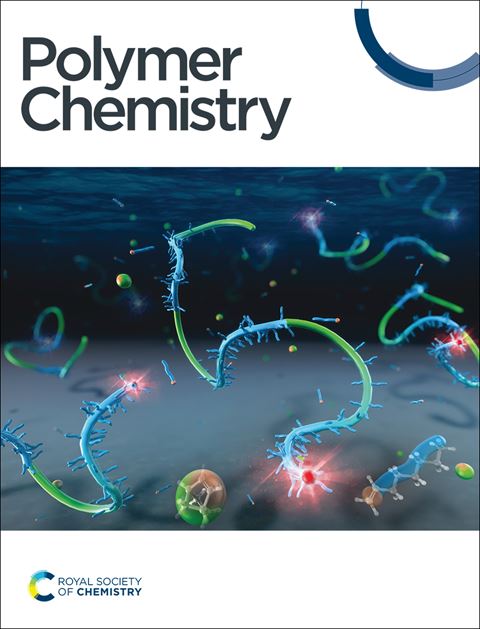Designing catechol-poly(ethylene terephthalate) as a depolymerizable adhesive for PET packaging
IF 3.9
2区 化学
Q2 POLYMER SCIENCE
引用次数: 0
Abstract
2,3-Dihydroxyterephthalate, a catechol-functionalized derivative of the conventional poly(ethylene terephthalate) monomer, was converted into a reactive monomer that polymerized into polyesters that exhibit adhesive properties. The monomer synthesis required two steps that were achieved with a global yield of 95%, with the photoprotecting groups, ortho-nitrobenzyl (ONB), on the catechol to prevent side reactions. Polymerization with ethylene glycol produced the catechol-protected material, poly(ONB-2,3-dihydroxyterephthalate) (ONB-c-PET), whereby changing the polymerization conditions, molecular weights ranged from 3,000 – 8,000 g/mol with dispersity values ranging from 1.13 – 1.72. These polymers were deprotected using a UV lamp (370 nm), producing poly(2,3-dihydroxyterephthalate), c-PET. The glass transition temperatures (Tg) measured for ONB-c-PET and c-PET were 34 °C and 56 °C, respectively. Adhesion lap-shear testing of c-PET showed adhesion (ASTM D1002) of 0.77 ± 0.09 MPa and 0.38 ± 0.11 MPa on a PET substrate. Degradation studies showed complete conversion to monomers via methanolysis over 16 hours. The resulting monomers, 2,3-dihydroxyterephthalic acid and 2,3-dihydroxyterephthalate, can be separated from ethylene terephthalate due to their water solubility. These results highlight the potential of this adhesive to facilitate the recycling of plastic materials contaminated with residual adhesives.设计儿茶酚聚对苯二甲酸乙酯作为PET包装的解聚胶粘剂
2,3-二羟基对苯二甲酸酯是传统聚(对苯二甲酸乙酯)单体的儿茶酚功能化衍生物,被转化为反应性单体,聚合成具有粘合性能的聚酯。单体的合成需要两个步骤,总产率达到95%,邻硝基苯基(ONB)在儿茶酚上具有光保护基团,以防止副反应。与乙二醇聚合制得保护儿茶酚的材料聚(onb -2,3-二羟基对苯二甲酸乙二醇酯)(ONB-c-PET),通过改变聚合条件,分子量在3,000 - 8,000 g/mol之间,分散值在1.13 - 1.72之间。这些聚合物使用紫外灯(370 nm)去保护,得到聚(2,3-二羟基对苯二甲酸酯),c-PET。ONB-c-PET和C - pet的玻璃化转变温度(Tg)分别为34℃和56℃。c-PET在PET基材上的粘附力(ASTM D1002)分别为0.77±0.09 MPa和0.38±0.11 MPa。降解研究表明,在16小时内通过甲醇分解完全转化为单体。所得到的单体2,3-二羟基对苯二甲酸和2,3-二羟基对苯二甲酸酯由于其水溶性可以从对苯二甲酸乙酯中分离出来。这些结果突出了这种粘合剂的潜力,以促进塑料材料的回收污染残留粘合剂。
本文章由计算机程序翻译,如有差异,请以英文原文为准。
求助全文
约1分钟内获得全文
求助全文
来源期刊

Polymer Chemistry
POLYMER SCIENCE-
CiteScore
8.60
自引率
8.70%
发文量
535
审稿时长
1.7 months
期刊介绍:
Polymer Chemistry welcomes submissions in all areas of polymer science that have a strong focus on macromolecular chemistry. Manuscripts may cover a broad range of fields, yet no direct application focus is required.
 求助内容:
求助内容: 应助结果提醒方式:
应助结果提醒方式:


